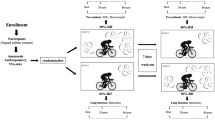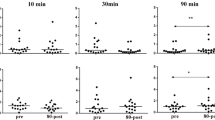Abstract
Purpose
The respiratory redox-state of swimmers can be affected by chronic exposures to chlorinated pools, and the effects of different exercises on it are unknown. Our aim was to compare two exercises performed at high-intensity and under habitual environmental conditions (swimming indoor vs. running outdoor) on the production of pro-oxidants (hydrogen peroxide and nitrite) and pH in exhaled breath condensate (EBC) and spirometry parameters in competitive swimmers chronically exposed to chlorinated pools.
Methods
Seventeen men and women (mean age ± SD = 21 ± 2 years) swam 3.5 km in an indoor pool treated with Cl2, and after 2-weeks, they ran 10 km outdoors. The pHEBC, [H2O2]EBC, [NO2−]EBC, [NO2−]EBC/[NO2−]Plasma and spirometry parameters were analyzed pre-exercise and 20 min and 24 h after exercise ended.
Results
Two mixed models were applied to compare EBC parameters between swimming and running. Lower levels of [H2O2]EBC and [NO2−]EBC (p = 0.008 and p = 0.018, respectively) were found 24-h post-swimming, and the same trend was observed for [NO2−]EBC/[NO2−]Plasma (p = 0.062). Correlations were found in both exercises between pre-exercise levels of pHEBC, [H2O2]EBC, [NO2−]EBC, and [NO2−]EBC/[NO2−]Plasma and their changes (Δ) after 24-h as well as between [H2O2]EBC and [NO2−]EBC for basal levels and for changes after 24 h. A relationship was also found for running exercise between pulmonary ventilation and changes after 24 h in [H2O2]EBC. Spirometry data were unaffected in both types of exercise.
Conclusion
In competitive swimmers, at 24-h acute post-exercise follow-up, swimming decreased and running increased pro-oxidant biomarkers of pulmonary origin, without changes in lung function.




Similar content being viewed by others
Abbreviations
- DBP:
-
Derived by-products
- EBC:
-
Exhaled breath condensate
- H2O2 :
-
Hydrogen peroxide
- NO2 − :
-
Nitrite anion
- \(\dot {V}{{\text{O}}_2}{\text{~max}}\) :
-
Maximal oxygen consumption
References
Araneda OF, Tuesta M (2012) Lung oxidative damage by hypoxia. Oxid Med Cell Longev 2012:856918. https://doi.org/10.1155/2012/856918
Araneda OF, García C, Lagos N et al (2005) Lung oxidative stress as related to exercise and altitude. Lipid peroxidation evidence in exhaled breath condensate: a possible predictor of acute mountain sickness. Eur J Appl Physiol 95:383–390. https://doi.org/10.1007/s00421-005-0047-y
Araneda OF, Guevara AJ, Contreras C et al (2012) Exhaled breath condensate analysis after long distance races. Int J Sports Med 33:955–961. https://doi.org/10.1055/s-0032-1316314
Araneda OF, Urbina-Stagno R, Tuesta M et al (2014) Increase of pro-oxidants with no evidence of lipid peroxidation in exhaled breath condensate after a 10-km race in non-athletes. J Physiol Biochem 70:107–115. https://doi.org/10.1007/s13105-013-0285-0
Bonetto G, Corradi M, Carraro S et al (2006) Longitudinal monitoring of lung injury in children after acute chlorine exposure in a swimming pool. Am J Respir Crit Care Med 174:545–549. https://doi.org/10.1164/rccm.200509-1392OC
Bonsignore M, Morici G, Riccobono L et al (2003) Airway cells after swimming outdoors or in the sea in nonasthmatic athletes. Med Sci Sport Exerc 35:1146–1152. https://doi.org/10.1249/01.MSS.0000074581.08023.25
Carbonnelle S, Francaux M, Doyle I et al (2002) Changes in serum pneumoproteins caused by short-term exposures to nitrogen trichloride in indoor chlorinated swimming pools. Biomarkers 7:464–478. https://doi.org/10.1080/13547500210166612
Carbonnelle S, Bernard A, Doyle IR et al (2008) Fractional exhaled NO and serum pneumoproteins after swimming in a chlorinated pool. Med Sci Sports Exerc 40:1472–1476. https://doi.org/10.1249/MSS.0b013e3181733159
Carlisle AJ, Sharp NC (2001) Exercise and outdoor ambient air pollution. Br J Sports Med 35:214–222
Day JR, Rossiter HB, Coats EM et al (2003) The maximally attainable V̇o 2 during exercise in humans: the peak vs. maximum issue. J Appl Physiol 95:1901–1907. https://doi.org/10.1152/japplphysiol.00024.2003
Drobnic F, Freixa A, Casan P et al (1996) Assessment of chlorine exposure in swimmers during training. Med Sci Sports Exerc 28:271–274
Evans RB (2005) Chlorine: state of the art. Lung 183:151–167. https://doi.org/10.1007/s00408-004-2530-3
Finaud J, Lac G, Filaire E (2006) Oxidative stress: relationship with exercise and training. Sports Med 36:327–358
Font-Ribera L, Kogevinas M, Zock J-P et al (2010) Short-term changes in respiratory biomarkers after swimming in a chlorinated pool. Environ Health Perspect 118:1538–1544. https://doi.org/10.1289/ehp.1001961
Font-Ribera L, Villanueva CM, Nieuwenhuijsen MJ et al (2011) Swimming pool attendance, asthma, allergies, and lung function in the avon longitudinal study of parents and children Cohort. Am J Respir Crit Care Med 183:582–588. https://doi.org/10.1164/rccm.201005-0761OC
Freed AN, Davis MS (1999) Hyperventilation with dry air increases airway surface fluid osmolality in canine peripheral airways. Am J Respir Crit Care Med 159:1101–1107. https://doi.org/10.1164/ajrccm.159.4.9802072
Gay CA, Gebicki JM (2002) Perchloric acid enhances sensitivity and reproducibility of the ferric-xylenol orange peroxide assay. Anal Biochem 304:42–46. https://doi.org/10.1006/abio.2001.5566
Goodman M, Hays S (2008) Asthma and swimming: a meta-analysis. J Asthma 45:639–647. https://doi.org/10.1080/02770900802165980
Green LC, Wagner DA, Glogowski J et al (1982) Analysis of nitrate, nitrite, and [15N]nitrate in biological fluids. Anal Biochem 126:131–138
Horváth I, Hunt J, Barnes PJ et al (2005) Exhaled breath condensate: methodological recommendations and unresolved questions. Eur Respir J 26:523–548. https://doi.org/10.1183/09031936.05.00029705
Huang W, Wang G, Lu S-E et al (2012) Inflammatory and oxidative stress responses of healthy young adults to changes in air quality during the Beijing Olympics. Am J Respir Crit Care Med 186:1150–1159. https://doi.org/10.1164/rccm.201205-0850OC
Knudson RJ, Lebowitz MD, Holberg CJ, Burrows B (1983) Changes in the normal maximal expiratory flow-volume curve with growth and aging. Am Rev Respir Dis 127:725–734. https://doi.org/10.1164/arrd.1983.127.6.725
Liang Y, Yeligar SM, Brown LAS (2012) Exhaled breath condensate: a promising source for biomarkers of lung disease. Sci World J 2012:1–7. https://doi.org/10.1100/2012/217518
Lima TM de, Kazama CM, Koczulla AR et al (2013) pH in exhaled breath condensate and nasal lavage as a biomarker of air pollution-related inflammation in street traffic-controllers and office-workers. Clinics (Sao Paulo) 68:1488–1494. https://doi.org/10.6061/clinics/2013(12)03
Marek E, Volke J, Mückenhoff K et al (2013) Exercise in cold air and hydrogen peroxide release in exhaled breath condensate. Adv Exp Med Biol 756:169–177. https://doi.org/10.1007/978-94-007-4549-0_22
Marr LC, Ely MR (2010) Effect of air pollution on marathon running performance. Med Sci Sports Exerc 42:585–591. https://doi.org/10.1249/MSS.0b013e3181b84a85
Martin JG, Campbell HR, Iijima H et al (2003) Chlorine-induced injury to the airways in mice. Am J Respir Crit Care Med 168:568–574. https://doi.org/10.1164/rccm.200201-021OC
Miller MR, Hankinson J, Brusasco V et al (2005) Standardisation of spirometry. Eur Respir J 26:319–338. https://doi.org/10.1183/09031936.05.00034805
Morissette MC, Murray N, Turmel J et al (2016) Increased exhaled breath condensate 8-isoprostane after a swimming session in competitive swimmers. Eur J Sport Sci 16:569–576. https://doi.org/10.1080/17461391.2015.1063702
Murata K, Fujimoto K, Kitaguchi Y et al (2014) Hydrogen peroxide content and pH of expired breath condensate from patients with asthma and COPD. COPD 11:81–87. https://doi.org/10.3109/15412555.2013.830094
Niess AM, Sommer M, Schlotz E et al (2000) Expression of the inducible nitric oxide synthase (iNOS) in human leukocytes: responses to running exercise. Med Sci Sports Exerc 32:1220–1225
Nourooz-Zadeh J, Tajaddini-Sarmadi J, Wolff SP (1994) Measurement of plasma hydroperoxide concentrations by the ferrous oxidation-xylenol orange assay in conjunction with triphenylphosphine. Anal Biochem 220:403–409
Nowak D, Kalucka S, Białasiewicz P, Król M (2001) Exhalation of H2O2 and thiobarbituric acid reactive substances (TBARs) by healthy subjects. Free Radic Biol Med 30:178–186
Paget-Brown AO, Ngamtrakulpanit L, Smith A et al (2006) Normative data for pH of exhaled breath condensate. Chest 129:426–430. https://doi.org/10.1378/chest.129.2.426
Pedersen L, Lund TK, Mølgaard E et al (2009) The acute effect of swimming on airway inflammation in adolescent elite swimmers. J Allergy Clin Immunol 123:502–504. https://doi.org/10.1016/j.jaci.2008.11.039
Pierson WE, Covert DS, Koenig JQ et al (1986) Implications of air pollution effects on athletic performance. Med Sci Sports Exerc 18:322–327
Powers SK, Jackson MJ (2008) Exercise-induced oxidative stress: cellular mechanisms and impact on muscle force production. Physiol Rev 88:1243–1276. https://doi.org/10.1152/physrev.00031.2007
Radak Z, Chung HY, Goto S (2008) Systemic adaptation to oxidative challenge induced by regular exercise. Free Radic Biol Med 44:153–159. https://doi.org/10.1016/j.freeradbiomed.2007.01.029
Ricciardolo FLM, Sterk PJ, Gaston B, Folkerts G (2004) Nitric oxide in health and disease of the respiratory system. Physiol Rev 84:731–765. https://doi.org/10.1152/physrev.00034.2003
Tuesta M, Alvear M, Carbonell T et al (2016) Effect of exercise duration on pro-oxidants and pH in exhaled breath condensate in humans. J Physiol Biochem 72:353–360. https://doi.org/10.1007/s13105-016-0486-4
Valenzuela OFA, Encina MPS (2009) Design and evaluation of a device for collecting exhaled breath condensate. J Bras Pneumol 35:69–72
Walsh NP, Gleeson M, Shephard RJ et al (2011) Position statement. Part one: Immune function and exercise. Exerc Immunol Rev 17:6–63
White CW, Martin JG (2010) Chlorine gas inhalation: human clinical evidence of toxicity and experience in animal models. Proc Am Thorac Soc 7:257–263. https://doi.org/10.1513/pats.201001-008SM
Acknowledgements
This work was supported by the National Fund for Scientific and Technological Development FONDECYT 11130082 (O.A). We acknowledge Mr. Luis Pizarro Zúñiga for technical assistance.
Author information
Authors and Affiliations
Contributions
O.A: conceived and design research, analysed data, manuscript redaction, final approval. F.C: conceived and design research, analysed data, manuscript redaction, final approval. G.C: analysed data. G.V: analysed data, manuscript redaction, final approval.
Corresponding author
Ethics declarations
Conflict of interest
The authors declare that there is no conflict of interest.
Additional information
Communicated by I. Mark Olfert.
Electronic supplementary material
Below is the link to the electronic supplementary material.
Rights and permissions
About this article
Cite this article
Araneda, O.F., Contreras-Briceño, F., Cavada, G. et al. Swimming versus running: effects on exhaled breath condensate pro-oxidants and pH. Eur J Appl Physiol 118, 2319–2329 (2018). https://doi.org/10.1007/s00421-018-3958-0
Received:
Accepted:
Published:
Issue Date:
DOI: https://doi.org/10.1007/s00421-018-3958-0




